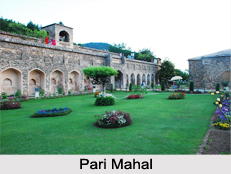 Pari Mahal or The Fairies` Abode is a seven terraced garden located at the top of Zabarwan mountain range over-looking city of Srinagar, in Srinagar District of Jammu and Kashmir and south-west of Dal Lake in Jammu and Kashmir.
Pari Mahal or The Fairies` Abode is a seven terraced garden located at the top of Zabarwan mountain range over-looking city of Srinagar, in Srinagar District of Jammu and Kashmir and south-west of Dal Lake in Jammu and Kashmir.
History of Pari Mahal
Pari Mahal was built by Mughal Prince Dara Shikoh in the mid-1600s. It served as a library and an abode for him. Dara Shikoh was said to have lived in this area in the years 1640, 1645, and 1654, when his father Shah Jahan was the king of Delhi in Mughal suzerainty.
Architecture of Pari Mahal
The architecture of Pari Mahal depicts an example of Islamic architecture and patronage of art during the reign of the then Mughal Emperor Shah Jahan. It is five-minute drive from Cheshmashahi Gardens in Srinagar, the capital city of modern Jammu and Kashmir.
Use of Pari Mahal in Mughal Era
Pari Mahal was further used as an observatory, useful for teaching astrology and astronomy. The gardens have since become the property of the Government of Jammu and Kashmir in modern India, and now is the alluring tourism destination in Zabarwan mountain range, while having a trek there.
Tourism in Pari Mahal
Pari Mahal has a beautiful view of the Dal Lake and Srinagar in Srinagar District of Jammu and Kashmir from the top. It serves now as the tourist attraction in Jammu and Kashmir like the other historical architecture in India. Pari Mahal is very close of Chasma Shahi Garden that was built by Shah Jahan.
Visiting Information
As Pari Mahal is located in the Zabarwan mountain range in Jammu and Kashmir, it has dropped the freezing temperature during winter months, while on summers are cool and temperate. The garden of Pari Mahal is open for public visit from 9:30am to 5:30 pm, daily. The national and international tourists are advised to show their ID cards while visiting this place. Pari Mahal in Zabarwan mountain range has the good railway transportation for the tourists. The Srinagar Railway Station is located at about 19 kilometres and Srinagar Airport is about 22 kilometers. It will nearly take 30 minutes drive with a cab.
Related Articles
Medieval History of India
Islamic Architecture
Mughal Architecture
Gardens in Mughal Architecture
Culture of Jammu and Kashmir
Jammu and Kashmir, Indian State
Costumes of Jammu and Kashmir



















